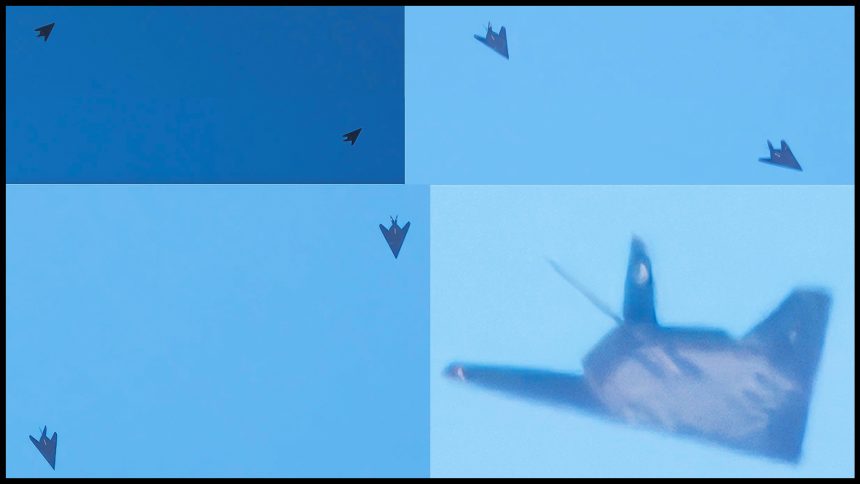Aviation spotter Michał Rokita captured two F-117s landing at Groom Lake, where the stealth fighters have relocated as Tonopah Test Range Airport undergoes maintenance.
Over the last couple of years, we have published a few articles featuring videos by Michał Rokita, an aviation spotter and photographer known for traveling to remote public lands in Nevada to capture rare glimpses of secretive military activities, particularly around Tonopah Test Range Airport and its F-117 Nighthawks. Now, Rokita provides fresh insight, with a new clip capturing two F-117s currently operating out of Groom Lake, the legendary Area 51, while Tonopah undergoes major reconstruction works.
Although news of Tonopah’s temporary closure had already emerged, Rokita’s new video provides visual confirmation that the F-117s have returned, at least temporarily, to their original home at Groom Lake, where the iconic stealth fighters were first tested under strict secrecy during the early 1980s before starting clandestine operations at Tonopah. The footage marks a rare and historic sighting, bridging past and present for one of the most iconic aircraft in aviation history.
The closure of the airport is also confirmed by a NOTAM (Notice to Airmen), which further specifies that Tonopah will be closed until July 18, 2025.
Tonopah Test Range (KTNX) is currently closed per NOTAM until July 18th. There were x2 F-117s (callsign NIGHT) spotted at Groom Lake the other day from Tikaboo Peak. You can see one jettison it’s chute on the runway. They’re returning back to the womb. 😎
🎥 n01_b4_flash pic.twitter.com/LCZFr3BiI5
— Thenewarea51 (@thenewarea51) April 26, 2025
The latest video published by Rokita on his YouTube channel “n01_b4_flash” shows flight activity at the secretive base on Apr. 8-10, 2025. Among the aircraft he was able to catch are some common visitors of Groom Lake, such as the Janet B737 and Beech King Air aircraft, as well as two visitors from the other secretive airport in the area.
“This time I was fortunate to catch F-117s ops at… Groom Lake!” told us Michał. “That is very special moment for me as I wanted to catch them particularly there, thinking that this is their current base with TTR being under reconstruction work at the moment, and mind you, I just saw what I wanted to see – simply amazing!”
The F-117 Nighthawk, the aircraft that doesn’t want to retire, is becoming once again an increasingly common sighting across the U.S. and is being often spotted also in low flight areas such as the famous Sidewinder transition, also known as Star Wars Canyon. It is no secret that the aircraft is being used both for training and testing, as demonstrated by the participation to multiple exercises such as Northern Edge.
Golden Hour#F117 #f117nighthawk pic.twitter.com/OcEUvXdqT5
— jmh.creates (@JarodMHamilton) March 9, 2025
Remarkably, Michał also spotted two mysterious aircraft, which were flying with the callsign “MIG,” as opposed to the F-117’s callsign “NIGHT.” The combination of haze and distance doesn’t allow to identify, but a multitude of aircraft are known to operate there, including F-16s.
Previous Area 51 spotting
Last year, Michał was once again in the area nearby Groom Lake, on Tikaboo Peak, an 8,000 ft mountain located approximately 26 miles to the east of Groom Lake. He spent the night there, and was almost able to catch something very interesting.
In fact, while throughout the night the base remained mostly quiet, the base’s personnel was preparing to launch a secretive aircraft in the darkness of the night. However, a UH-60 helicopter was sent to investigate a “Watchdog Tango”.
Groom Lake Viper! 🛸🛸 pic.twitter.com/0a0zErmPNe
— jmh.creates (@JarodMHamilton) April 23, 2025
The term “Watchdog Tango”, which combines the idea of a spotter (watchdog) and Tikaboo (Tango, the phonetic ‘T’), is the codeword used over radio comms for spotters at Tikaboo watching. In this case, the Watchdog Tango condition led to the cancellation of a mission about to launch from Area 51, highlighting the secretive base’s remarkable detection capabilities, even in complete darkness and from 26 miles away.
In other words, they are aware of observers on public land (the helicopter is most probably dispatched to confirm what other sensors located there may have collected) and will not conduct clandestine flight tests if there is any risk of disclosing sensitive information.
The F-117 continues to fly
Here is what we previously wrote about the F-117 still being in activity today, even if it was officially retired by the U.S. Air Force in 2008:
We have reported in details that 15 years after being officially retired, the F-117s are still flying not only for training purposes as adversary aircraft and cruise missile surrogate, but also for research, development, test and evaluation, possibly related to next generation programs.
In accordance with the Nation Defense Authorization Act (NDAA) of 2007 (PL 109- 364, Section 136), 52 F-117 aircraft were retired and relocated to the Tonopah Test Range (TTR). Under the requirements of the NDAA, the USAF preserved each F-117 aircraft in Type-l000 (T-1000) storage, which maintains the aircraft in a condition that allows recall for future service. On 30 November 2016, Section 133 of Subtitle D of the National Defense Authorization Act repealed the requirement to preserve the F-117 aircraft in a recallable condition and the USAF intended to declassify, demilitarize, and disposition four F-117 aircraft per year.
The aircraft continued to be spotted, even more than it had happened until then, with the Nighthawks also deploying to several U.S. bases to carry out Dissimilar Air Combat Training with other U.S. types. Then, in 2021, the U.S. Air Force published the first official images of the type still involved in flight operations on the DVIDS (Defense Visual Information Distribution Service) network.
In September 2022 the Air Force Test Center published a Request For Information (RFI) about a possible 10-year contract for maintenance and logistics support services for the F-117A fleet at the TTR airfield, acknowledging that the U.S. Air Force is willing to keep the aircraft flying at least until 2034.
In 2024, reports mentioned that the Air Force was planning to certify the F-117A Nighthawk to be able to refuel from the KC-46A Pegasus, the service’s new tanker. The news was first anticipated by Andrew Hunter, then the Air Force’s Service Acquisition Executive, to the House Armed Services Subcommittee on Seapower and Projection Forces.
It is not known how many Nighthawks are still airworthy. As of January 2023, of the 59 F-117s built, approximately 45 F-117s were in the inventory, with more than 10 already approved for transfer to museums. The current disposal rate is only between two and three jets per year, instead of four per year announced in 2017.
A big thank you to Michał “n01_b4_flash” Rokita for sharing the video with us. Take a look and subscribe to his YouTube channel here.









